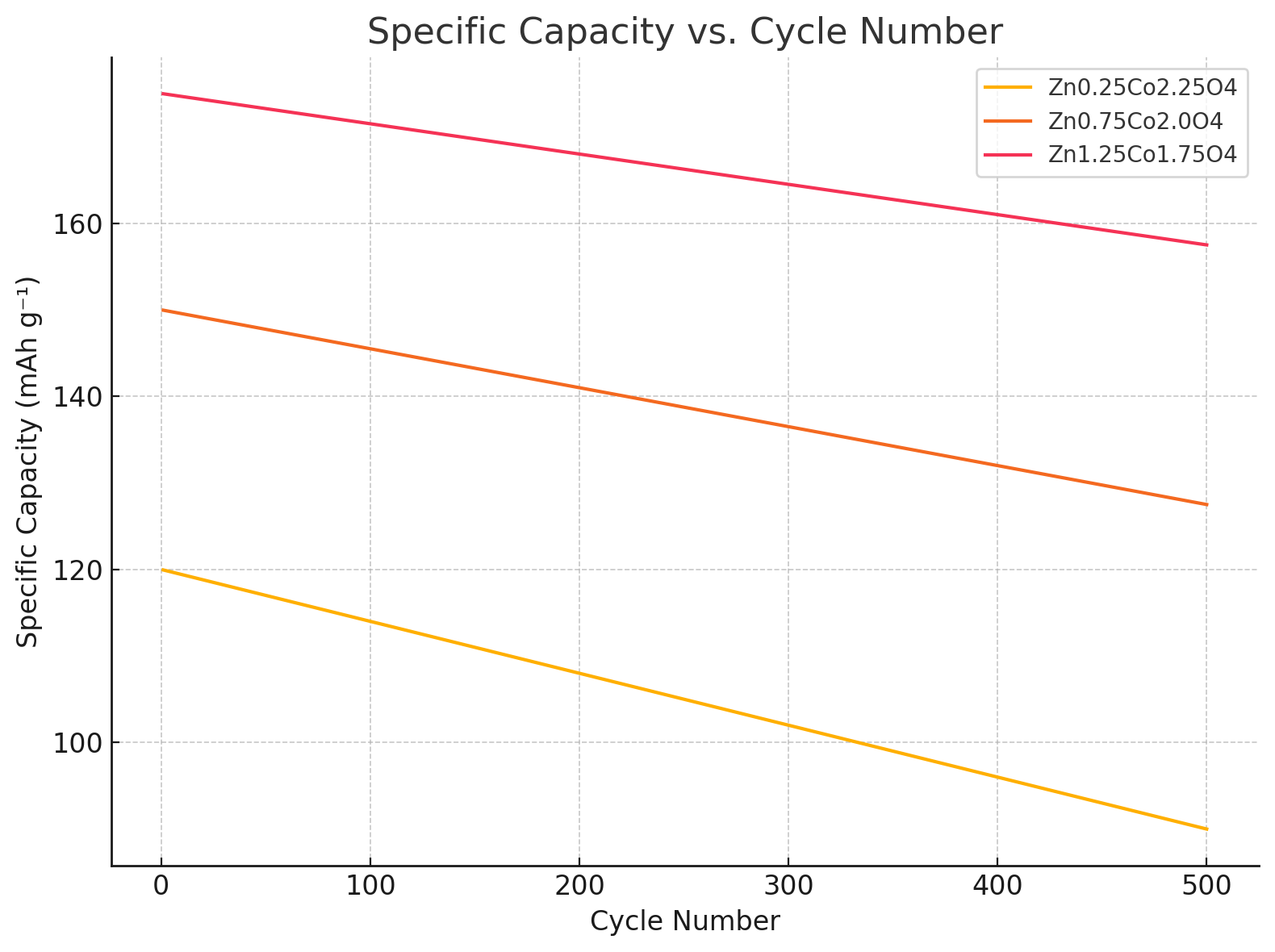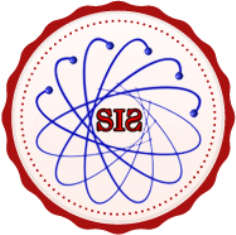AI-Based Stoichiometric Engineering of Zinc Cobaltite
Keywords:
Stoichiometric Variations, Zinc Cobaltite, Electrochemical Performance, Structure-Property-PerformanceAbstract
This study investigates the impact of stoichiometric variations and defect engineering on the structural, electrical, and electrochemical properties of zinc cobaltite (Zn1-xCo(1+x)-O4) synthesized via a modified sol-gel method. By systematically varying the Zn: Co ratio, an optimal composition, Zn0.75Co2.25O4, was identified, demonstrating superior performance metrics. SEM images confirmed the morphological changes of spinel phase, with lattice parameter variations correlating to Zn content. EIS analysis revealed that moderate oxygen vacancies significantly enhanced conductivity, with Zn0.75Co2.25O4 exhibiting the highest electrical and electrochemical performance. The optimized material achieved a specific capacity of 290 mAh/g at 1 A g-1 and retained ~90% capacity after 500 cycles, surpassing prior benchmarks. This study provides a detailed understanding of the structure-property-performance relationship, highlighting the potential of defect-engineered zinc cobaltite for advanced energy storage applications.
References
C. Guo, M. Yin, C. Wu, J. Li, C. Sun, and C. Jia, "Highly stable gully-network Co₃O₄ nanowire arrays as battery-type electrode for outstanding supercapacitor performance," Front. Chem., vol. 6, p. 636, 2018. [Online]. Available: https://doi.org/10.3389/fchem.2018.00636.
H. Sun, Y. Miao, G. Wang, X. Ren, E. Bao, X. Han, Y. Wang, X. Ma, C. Xu, and H. Chen, "Flower-like ZnCo₂O₄ microstructures with large specific surface area serve as battery-type cathode for high-performance supercapacitors," J. Energy Stor., vol. 72, p. 108502, 2023. [Online]. Available: https://doi.org/10.1016/j.est.2023.108502.
J. Sun, X. Du, R. Wu, Y. Zhang, C. Xu, and H. Chen, "Bundle-like CuCo₂O₄ microstructures assembled with ultrathin nanosheets as battery-type electrode materials for high-performance hybrid supercapacitors," ACS Appl. Energy Mater., vol. 3, pp. 8026–8037, 2020. [DOI: 10.1021/acsaem.0c01458].
H. Chen, X. Du, X. Liu, R. Wu, Y. Li, and C. Xu, "Facile growth of nickel foam-supported MnCo₂O₄.₅ porous nanowires as binder-free electrodes for high-performance hybrid supercapacitors," J. Energy Stor., vol. 50, p. 104297, 2022. [Online]. Available: https://doi.org/10.1016/j.est.2022.104297.
E. Bao, X. Ren, R. Wu, X. Liu, H. Chen, Y. Li, and C. Xu, "Porous MgCo₂O₄ nanoflakes serve as electrode materials for hybrid supercapacitors with excellent performance," J. Colloid Interface Sci., vol. 625, pp. 925–935, 2022. [Online]. Available: https://doi.org/10.1016/j.jcis.2022.06.098.
H. Chen et al., "Battery-type and binder-free MgCo₂O₄-NWs@NF electrode materials for the assembly of advanced hybrid supercapacitors," Int. J. Hydrogen Energy, 2022.
H. Chen et al., "Facile growth of nickel foam-supported MnCo₂O₄.₅ porous nanowires as binder-free electrodes for high-performance hybrid supercapacitors," J. Storage Mater., 2022.
S. B. Dhavale et al., "Study of solvent variation on controlled synthesis of different nanostructured NiCo₂O₄ thin films for supercapacitive application," J. Colloid Interface Sci., vol. 584, pp. 217–227, 2021.
P. Forouzandeh et al., "Two-dimensional (2D) electrode materials for supercapacitors," Mater. Today Proc., 2021.
H.-J. Kim et al., "An advanced nano-sticks & flake-type architecture of manganese-cobalt oxide as an effective electrode material for supercapacitor applications," J. Energy Storage, vol. 34, p. 101971, 2021.
Y. A. Kumar et al., "Reagents assisted ZnCo₂O₄ nanomaterial for supercapacitor Application," Electrochim. Acta, vol. 333, pp. 370–380, 2020.
Y. A. Kumar et al., "Facile synthesis of efficient construction of tungsten disulfide/iron cobaltite nanocomposite grown on nickel foam as a battery-type energy material for electrochemical supercapacitors with superior performance," J. Colloid Interface Sci., vol. 593, pp. 198–208, 2022.
Y.-S. Lee et al., "CoCu₂O₄ nanoflowers architecture as an electrode material for battery-type supercapacitor with improved electrochemical performance," Nano-Structures & Nano-Objects, vol. 21, pp. 100402, 2020.
Q. Li et al., "Facile synthesis of mesoporous CuCo₂O₄ nanorods@MnO₂ with core-shell structure grown on RGO for high-performance supercapacitors," Mater. Lett., vol. 240, pp. 97–100, 2019.
Y. Liu et al., "Nanosheet-assembled porous MnCo₂O₄.₅ microflowers as electrode material for hybrid supercapacitors and lithium-ion batteries," J. Colloid Interface Sci., vol. 602, pp. 392–401, 2022.
F. Liao et al., "MnO₂ hierarchical microspheres assembled from porous nanoplates for high-performance supercapacitors," Ceram. Int., vol. 45, pp. 11625–11632, 2019.
G. R. Reddy et al., "Mechanistic investigation of defect-engineered, non-stoichiometric, and morphology-regulated hierarchical rhombus-/spindle-/peanut-like ZnCo₂O₄ microstructures and their applications toward high-performance supercapacitors," Appl. Surf. Sci., vol. 507, pp. 1274–1284, 2020. [DOI: 10.1016/j.apsusc.2019.04.144].
C. Huang et al., "PVP-assisted growth of Ni-Co oxide on N-doped reduced graphene oxide with enhanced pseudocapacitive behavior," Chem. Eng. J., vol. 355, pp. 1–10, 2019. [DOI: 10.1016/j.cej.2018.08.046].
A. Shanmugavani et al., "Improved electrochemical performances of CuCo₂O₄/CuO nanocomposites for asymmetric supercapacitors," Electrochim. Acta, vol. 211, pp. 524–532, 2016. [DOI: 10.1016/j.electacta.2016.05.031].
S. Zhou et al., "Metal-organic framework templated synthesis of porous NiCo₂O₄/ZnCo₂O₄/Co₃O₄ hollow polyhedral nanocages and their enhanced pseudocapacitive properties," Chem. Eng. J., vol. 334, pp. 723–732, 2018. [DOI: 10.1016/j.cej.2017.11.053].
M. A. A. Mohd Abdah et al., "Review of the use of transition-metal-oxide and conducting polymer-based fibres for high-performance supercapacitors," Mater. Des., vol. 186, p. 108259, 2020. [DOI: 10.1016/j.matdes.2019.108259].
J. Sun et al., "Rapid hydrothermal synthesis of snowflake-like ZnCo₂O₄/ZnO mesoporous microstructures with excellent electrochemical performances," Ceram. Int., vol. 45, pp. 11625–11632, 2019. [DOI: 10.1016/j.ceramint.2019.02.025].
K. T. Alali et al., "Enhanced acetone gas sensing response of ZnO/ZnCo₂O₄ nanotubes synthesized by single capillary electrospinning technology," Sensors Actuators B Chem., vol. 248, pp. 110–118, 2017. [DOI: 10.1016/j.snb.2017.03.070].
K. Munirathnam et al., "Investigations on surface chemical analysis using X-ray photoelectron spectroscopy and optical properties of Dy³⁺-doped LiNa₃P₂O₇ phosphor," J. Mol. Struct., vol. 1127, pp. 100–107, 2016. [DOI: 10.1016/j.molstruc.2016.07.001].

Downloads
Published
How to Cite
Issue
Section
License
Copyright (c) 2023 50Sea

This work is licensed under a Creative Commons Attribution 4.0 International License.




















